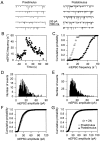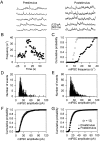Calcium elevation in astrocytes causes an NMDA receptor-dependent increase in the frequency of miniature synaptic currents in cultured hippocampal neurons
- PMID: 9712653
- PMCID: PMC6792963
- DOI: 10.1523/JNEUROSCI.18-17-06822.1998
Calcium elevation in astrocytes causes an NMDA receptor-dependent increase in the frequency of miniature synaptic currents in cultured hippocampal neurons
Abstract
Astrocytes exhibit a form of excitability and communication on the basis of intracellular Ca2+ variations (Cornell-Bell et al., 1990; Charles et al., 1991) that can be initiated by neuronal activity (Dani et al., 1992; Porter and McCarthy, 1996). A Ca2+ elevation in astrocytes induces the release of glutamate (Parpura et al., 1994; Pasti et al., 1997; Araque et al., 1998;Bezzi et al., 1998), which evokes a slow inward current in neurons and modulates action potential-evoked synaptic transmission between cultured hippocampal cells (Araque et al., 1998), suggesting that astrocytes and neurons may function as a network with bidirectional communication. Here we show that a Ca2+ elevation in astrocytes increases the frequency of excitatory as well as inhibitory miniature postsynaptic currents (mPSCs), without modifying their amplitudes. Thapsigargin incubation, microinjection of the Ca2+ chelator BAPTA, and photolysis of the Ca2+ cage NP-EGTA demonstrate that a Ca2+ elevation in astrocytes is both necessary and sufficient to modulate spontaneous transmitter release. This Ca2+-dependent release of glutamate from astrocytes enhances mPSC frequency by acting on NMDA glutamate receptors, because it is antagonized by D-2-amino-5-phosphonopentanoic acid (AP5) or extracellular Mg2+. These NMDA receptors are located extrasynaptically, because blockage specifically of synaptic NMDA receptors by synaptic activation in the presence of the open channel blocker MK-801 did not impair the AP5-sensitive astrocyte-induced increase of mPSC frequency. Therefore, astrocytes modulate spontaneous excitatory and inhibitory synaptic transmission by increasing the probability of transmitter release via the activation of NMDA receptors.
Figures






References
-
- Araque A, Parpura V, Sanzgiri RP, Haydon PG. Glutamate-dependent astrocyte modulation of synaptic transmission between cultured hippocampal neurons. Eur J Neurosci. 1998;10:2129–2142. - PubMed
-
- Bekkers JM, Stevens CF. NMDA and non-NMDA receptors are colocalized at individual excitatory synapses in cultured rat hippocampus. Nature. 1989;341:230–233. - PubMed
-
- Bezzi P, Carmignoto G, Pasti L, Vesce S, Rossi D, Lodi Rizzini B, Pozzan T, Volterra A. Prostaglandins stimulate calcium-dependent glutamate release in astrocytes. Nature. 1998;391:281–285. - PubMed
Publication types
MeSH terms
Substances
Grants and funding
LinkOut - more resources
Full Text Sources
Miscellaneous
